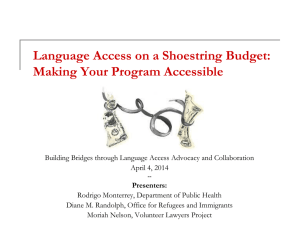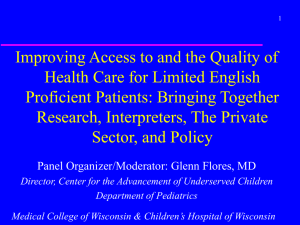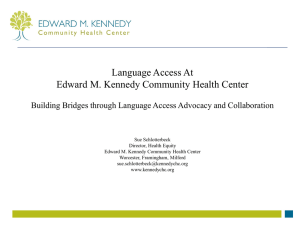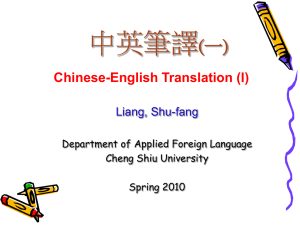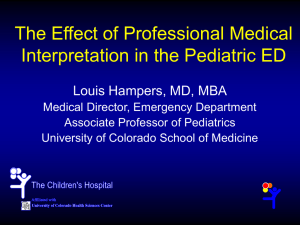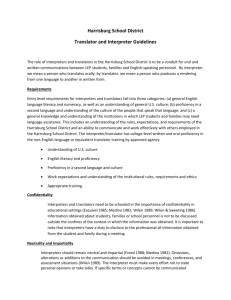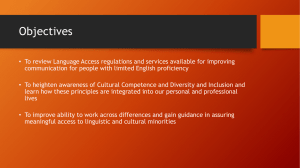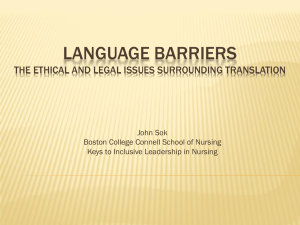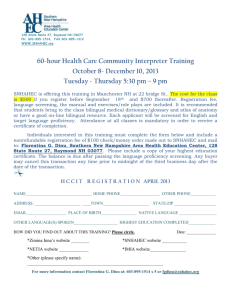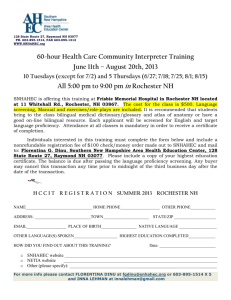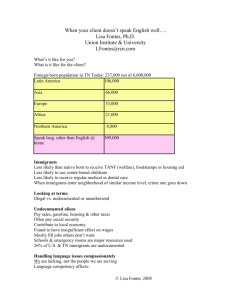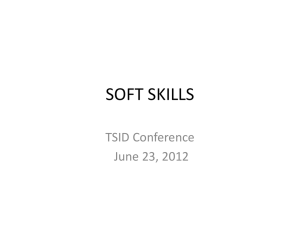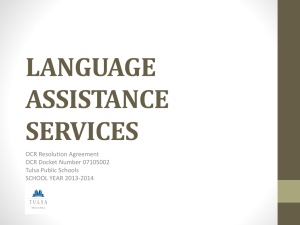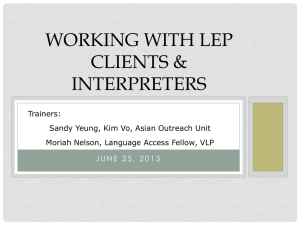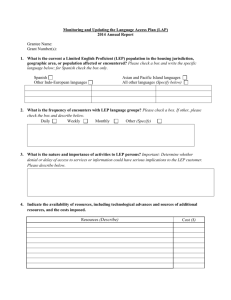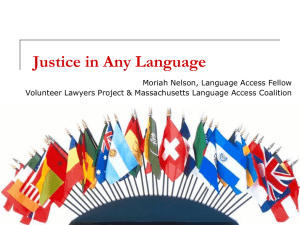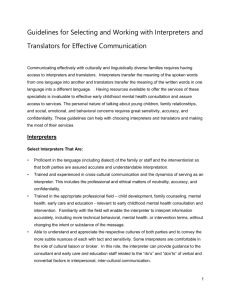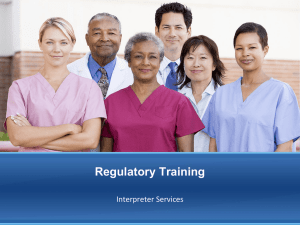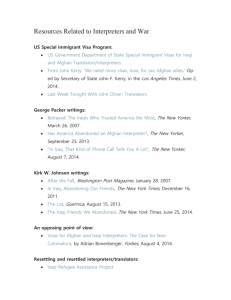PowerPoint format - Nebraska Association of Local Health Directors
advertisement
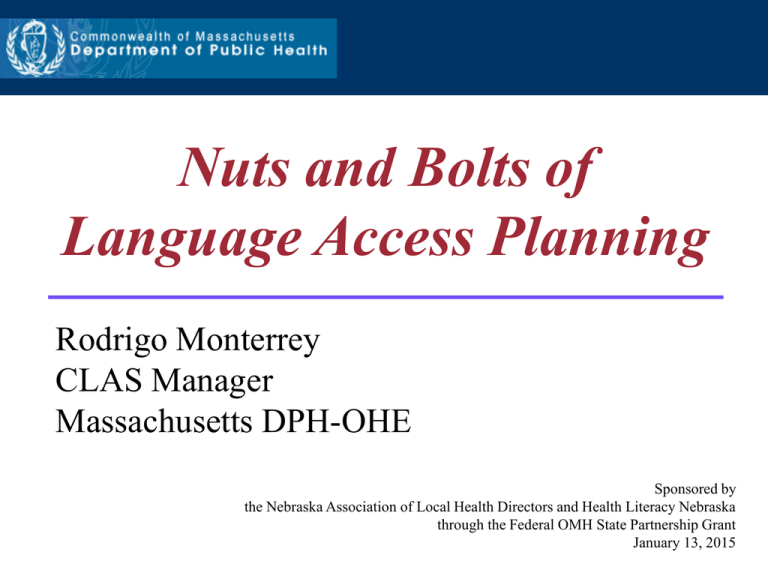
Nuts and Bolts of Language Access Planning Rodrigo Monterrey CLAS Manager Massachusetts DPH-OHE Sponsored by the Nebraska Association of Local Health Directors and Health Literacy Nebraska through the Federal OMH State Partnership Grant January 13, 2015 Agenda: 1. History of Language Access 2. Language Access as part of “CLAS” 3. Steps: How to develop and implement your own Language Access Plan 2 Key Terms: • Translation: written • Interpretation: spoken or American Sign Language, usually simultaneous • Bilingual Staff: proficient in additional language, understands content and protocols • Translator/Interpreter: trained or certified, contracted or volunteer • Vital Documents: critical records, consent forms, eligibility documents, notifications that require a response or action from a client 3 History : Federal: Executive Order #1366 (2000) – "Improving Access to Services for Persons with Limited English Proficiency" – Federal agencies (and those receiving federal funding) to ID services and implement system – Use of a specific approach to determining when/how to provide Language Access – Unfunded mandate 4 History (cont): State and Local Agencies (MA): • Chapter 151B of the General Laws, Executive Order 478, Administrative Bulletin #16 (2010) – Follows similar suit to the implementation of the national LA standards – Review of resources, populations, and agencyspecific language access plans 5 History (cont): Emergency Room Interpreters Law (ERIL 2000) 1. Before implementation (“land before time”): – Use of friends, family members – Use of available bilingual persons/staff 2. Post implementation (present): – – – – Competency a key element of interpreters Hospital-Based Interpreter Services Best Practice Guidance Training and Interpreter Credentialing Language access planning 6 LAP in CLAS: •What is “CLAS”? •How does Language Access Planning fit into CLAS? 7 CLAS: • Culturally and Linguistically Appropriate Services • 15 standards for service delivery • A framework for continuous quality improvement • Goal? To reduce health disparities • How? By creating culturally-competent systems of care 8 The Standards: Over-arching principle: #1 Governance, Leadership, Workforce: #2-4 Communication and Language Assistance: #5-8 Engagement, Continuous Improvement and Accountability: #9-15 9 The Steps: How to Develop and Implement Your Own Language Access Plan Framework: Plan-Do-Study-Act: Rapid-cycle process improvement (SMART Objectives) 11 Plan: • Who: include staff from various levels and clients/community-members/stakeholders • Why: review your mission/goals/needs. How will language access fit/benefit what you do? • What: determine where language access is most needed. What are you hoping to address/improve? • When: give yourself an end-date 12 Goal: “Ensure that LEP clients receive services in their preferred language” 1. 2. 3. 4. 5. 6. 7. 8. Organization Priority LA Working Group Assessment Policy, Plan & Procedures Interpreters & Translators Document Translation Training Evaluate 13 1. Organization Priority • In order to serve LEP clients • Unfunded mandate: – Operating cost – like the light bill – Line item for language services in budget • Include in all grant proposals and apply for grants specifically for language access work – Use data to show why it matters • Hire qualified bilingual staff 14 2. Working Group • Executive Director support • Participation from all levels of organization – Management/administrators – Front line (clinical and non-clinical) staff – Clients/advocates/stakeholders • Work plan, with SMART objectives, regular meetings and action steps (accountability) 15 3. Assessment • • • • • What are we already doing well? What resources do we already have? Where are the gaps in service? Who can we partner with? Then go after “low-hanging fruit” 16 4. Policy, Plan & Procedures Language Access Plan and Protocol Working document (never done) Working Group reviews/updates annually Staff routinely trained on it Clients made aware of it 17 5. Interpreters & Translators List of interpreters and translators Easily accessible by all staff Updated annually Volunteer and employee “bank” for needed languages List qualifications & skills (translation vs. interpretation) Quality Control (including certification boards) Application/Initial Screening Meeting/Interview with Referral Coordinator Interpreter Protocol & Code of Ethics (2006) Negotiated lower rate for phone interpreter and video remote interpreter services 18 6. Document Translation • Write in Plain Language! (Health Literacy) • Translated Document Bank Easily accessible to staff Informational materials for clients, staff, family Signs, notices, forms, vital information • Always have multiple people review • Then pay for proofreading – less expensive 19 7. Training • • • • • Build in-house training capacity (FREE) Online training resources (FREE) Partner with agencies, courts or orgs (FREE) LEP Training for all New Hires in Orientation Annual Staff Training – Working with an Interpreter, Language Access Plan & Protocol and Language Access Issues • Interpreter Skills-Building Training – Bilingual Staff and Privately Contracted Interpreters 20 8. Evaluation • Based on intended outcomes established in the workplan – concrete “measures” • “Benchmark” – set a baseline against which to measure progress (e.g. % increase) • Set up recurrence – periodic cycle for short, mid and long-term goals (monthly, quarterly, annual) 21 Elements of an LAP (template) 1. Purpose of the LAP 2. Mission/Vision 3. Populations Served/Populations within your catchment 4. Service Provisions of the LAP 5. Implementation 6. Complaint Procedure 7. Signatures: CEO, Dirs. (accountability) 22 Resources: • Agency/Program: http://www.mass.gov/eohhs/docs/dph/healthequity/clas-chapter6.pdf • State/County (example): www.montgomerycountymd.gov/LEP/ • Federal: http://www.lep.gov/ 23 Resources (cont): • How to work with an interpreter (video): http://www.health.medicbd.com/library/video?v q=working+with+interpreter&s=relevance&subm it=Search • Telephonic Interpreters: www.languageline.com www.ctslanguagelink.com www.pacificinterpreters.com www.callopi.com 24 Resources (cont): 25 Checklist: 26 Questions? Rodrigo Monterrey CLAS Coordinator DPH-Office of Health Equity 250 Washington St. Boston, MA 02108 rodrigo.monterrey@state.ma.us 617-994-9806 (office) 617-938-4024 (cell-phone) 27 Thank you! 28
